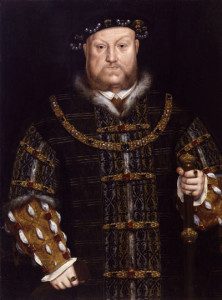Remodelling and Extension
Wolsey had 400 in his staff, Henry had more than twice that many, and if he had visitors, there was no telling how many would be there to empty the larder and fill the garde-robes. The first requirement was for greatly enlarged kitchens, and within a year of taking Hampton Court there was a 400% enlargement. Today they are in size as Henry built them, and measure 37 by 27 feet, though there is an addition of a fireplace. This is only part of the 50 room cooking complex which includes also the three huge fireplaces in the kitchen of Wolsey’s palace. The well known groups of decorated chimneys were a necessity for so many fireplaces. Extensive store rooms, wine cellars, beer brewing and storage are in keeping with the size of the kitchens and the requirements to serve multiple course meals to hundreds of gormandisers.

As a leading man of the church it was required that Wolsey would have his own chapel, but its decorative effects were lavishly enhanced by Henry, a carved wooden ceiling, painted blue, embellished with pendants and stars.
King Henry and his architects seem to have been unimaginative, or perhaps one should say conservative for several of the features he added to Wolsey’s Hampton Court are described as “the last of their kind in England.” The Great Hall was where Henry held audience, seated on a dais, under a canopy of estate; Henry started it in 1531, it took five years to complete even though the workers using candles as necessary were at it “twenty four by seven.” The roof is striking, a hammer beam construction, meaning, without tie-beams. The hall and numerous other places in his new palace were marked by Henry with Anne Boleyn’s initials, badges or other devices, many but not all were removed after the poor woman’s head was likewise dealt with.
When at Hampton Court, Henry had built for himself the Bayne Tower, the name derived from the French word for bath that we currently spell bain. He lived in the apartments that Wolsey had specifically designed for royalty. The Bayne Tower is the single survivor of Henry’s apartments, like other works of his, “the last of its kind to be built in England,” but is reported as not open to the public. Described as a donjon (like a castle keep), there are three stories, on the Ground Floor the Privy Chamber office and strong room, the 1st floor was the king’s study, bedroom and a bathroom (bain) with hot and cold running water, on the top floor was a two room library and his jewel room.
Beyond the Clock Court, what is now the Fountain Court, was in Henry’s time known as Cloister Green Court. In 1536 he added the wings that project beyond the Base Court, at each side of the moat over which he built a new bridge to replace the earlier one.
Henry had acquired 2000 tapestries, distributed through his various palaces, the bulk of them at Hampton Court where now only 28 remain. Some of the furnishings of Hampton Court were taken for his later creation, the Palace at Nonsuch.
Of the completed palace, it was reported by an envious ambassador that all the walls shone with gold and silver, many of the large rooms were embellished with masterly paintings, writing tables of mother of pearl; fretwork ceilings with pendants picked out in gold, and all the woodwork of the palace was either gilded or painted scarlet.
The throne room, called the Paradise Chamber, was off Cloister Green Court. The royal throne, upholstered in brown velvet, was studded with three great diamonds, rubies and sapphires. The horn room contained antlers of the deer caught in the hunt. Henry was a sportsman, very active and athletic, and hunted from horseback whenever he could.
Sanitary arrangements were no better in Henry’s day. Sir John Harrington observed, “Even in the goodliest and stateliest palaces in the realm notwithstanding provision of vaults, sluices and gates, or pains of poor folk in swilling and scouring, yet still this same whoreson saucy stink.” Upper levels of aristocracy had a person to wipe their rears after using the “close stool.” and a great privilege it was to provide the king with this service, but lesser persons were inclined to use the courtyard or against the walls, the incentive for Sir John to invent the water closet (Jakes)but not until 1596.
Among Henry’s recreational activities was tennis, his court at the north side of the palace is now the oldest surviving tennis court still in use.
